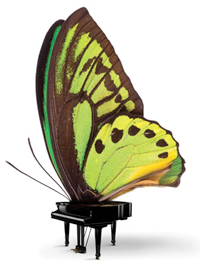by Daniel Hathaway
Friday afternoon’s opening set by 22-year-old Taiwanese pianist Meng-Sheng Shen was a bit puzzling. He gave undue emphasis to the bass line in J.S. Bach’s b-flat Prelude and punched out the subject in the fugue. Ebbs and flows in tempo and inconsistent articulation gave an unsettled quality to Chopin’s A-flat Etude (op. 10/10). In Beethoven’s opus 110 sonata, over-pedaling, exaggerated bass lines and an emphasis on secondary details visited the first two movements. In the finale, Shen held the sustaining pedal through chord changes and seemed not to know what to do with the spate of right hand repeated notes. Though the fugue was nicely voiced, an enormous bass line nearly overpowered everything else at the end.
29-year-old Russian pianist Stanislav Khristenko opened with a weighty account of Bach’s c minor prelude (WTC I). Its fugue subject changed character several times in a texture that was otherwise played completely staccato; the final statement in the bass was huge. Kristenko’s big piece was Brahms’s first sonata, op. 1, to which he brought perhaps too much horsepower (he has a lot to bring!) Aggressive rather than grand at the beginning, overly portentous in the middle movement for the little Minnelied on which it’s based, and overplayed in the finale with tone bordering on the harsh, his concept seemed altogether out of scale.
After a dark and quietly expressive performance of Bach’s g-sharp prelude and fugue (WTC I), U.S. pianist Henry Kramer, 26, pulled off a thrilling and nearly flawless performance of another Brahms work, the Variations on a Theme by Paganini. Playing with astonishingly confident technique, steady rhythm and masterful pacing, he dazzled the ear for twenty-five straight minutes. There’s not much more to say about it than Wow!
Maria Mazo (30, from Russia) might have rearranged her repertory for greater effect. She began with Beethoven’s “Pathétique” sonata, op. 13, the opening of which was unsettling, as she held each chord tenaciously before going forward with the dotted rhythms that come attached to them in the score. Big pauses interrupted the flow even further. The rest of the sonata went more conventionally and had its exciting moments even with some untidy passagework. The famous Adagio cantabile was nicely paced and sonorous. One of William Bolcom’s 12 New Etudes, “Butterflies, Hummingbirds” gave her the opportunity to change textures; she played cleanly and with a sense of garden drama. Bach’s F Major prelude and fugue (WTC II) followed in a frankly romantic interpretation replete with pedal. The fugue was played all staccato, which seemed to be in fashion this afternoon. Mazo’s final piece was Chopin’s “Revolutionary” Etude. She flashed through it with vigor and abundant technique; it needed only a big breath before the coda.
The fifth and last player of the afternoon, Quang Hong Luu, 22, from Vietnam, was the model of elegant understatement. Deliberate and delicate performances of two Scarlatti Sonatas (K. 9 and K. 1) featured sparkling open articulation and a fine sense of rhythm. Australian composer Carl Vine’s Five Bagatelles received fastidious readings from a pianist with a well-controlled sense of touch. He finished this interesting and varied afternoon session with Chopin’s “Black Keys” Etude: clean, bright and well-layered, with a fine flare of octaves at the end.
Published on ClevelandClassical.com August 2, 2013
Click here for a printable version of this article.




